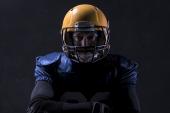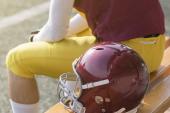CMR Boosts Detection of Myocarditis in College Athletes After COVID-19
But universal CMR screening isn’t feasible, and questions remain about what the imaging findings mean for long-term risk.

A strategy involving cardiovascular magnetic resonance (CMR) imaging for all college athletes who test positive for COVID-19 catches more cases of clinical or subclinical myocarditis than does a symptom-driven approach, according to findings from the Big Ten COVID-19 Cardiac Registry.
But the feasibility of implementing universal CMR screening is in doubt, and there are questions about whether it would ultimately prevent sudden cardiac death during athletic competition, which is already a rare occurrence.
Based on preliminary studies showing CMR evidence of myocarditis in college athletes with asymptomatic or symptomatic SARS-CoV-2 infections, the Big Ten Conference—which includes 14 universities—mandated advanced cardiac screening as part of its return-to-play protocols.
Data from the Big Ten registry, published online May 27, 2021, ahead of print in JAMA Cardiology, affirm that performing CMR in all athletes will catch more cases of myocarditis than a strategy in which cardiac symptoms trigger evaluation with a test triad of ECG, echocardiography, and serum troponin, with CMR only performed if one of those three tests is abnormal (2.3% vs 0.31%).
“MRI is the best test to diagnose myocarditis. I think that’s what we need to realize after this,” said Saurabh Rajpal, MBBS, MD, who was one of the lead authors of the study, along with Curt Daniels, MD (both Ohio State University, Columbus).
We are nowhere close to being ready to use cardiac MRI for screening in this group. Aaron Baggish
But whether universal CMR screening for all athletes who have had COVID-19 is realistic is another question altogether. Rajpal pointed out that availability of CMR and the expertise required to interpret the findings have to be considered, noting that the prevalence of myocarditis across schools included in this study ranged from zero to 7.6%. “That tells you that there is wide variability in how the MRI is done as well as how MRI is interpreted,” he said. “I think the biggest takeaway from our study is that the cardiac societies and the MRI societies need to get together and . . . come up with standardized criteria for diagnosis so that there is less variability.”
Aaron Baggish, MD (Massachusetts General Hospital, Boston, MA), who has been instrumental in developing return-to-play guidance in the setting of COVID-19 for both the American College of Cardiology (ACC) and the National Collegiate Athletic Association, highlighted additional factors that render a universal CMR strategy impractical. In addition to the expertise required to interpret the scans, there is the high cost of CMR and the lack of data indicating what findings are normal or not normal in athletes.
“We are nowhere close to being ready to use cardiac MRI for screening in this group,” Baggish told TCTMD.
Of note, he commented, the basic approach of screening for cardiac symptoms and then performing triad testing doesn’t find that many fewer cases of myocardial inflammation.
“Overall, it’s now entirely clear that this is a really low prevalence problem in this population, and perhaps the most important thing when you look at all the data we have in aggregate is that we haven’t seen a single adverse event in any of these young people who have had COVID and either had what people term cardiac involvement or did not,” Baggish said. “And we’ve got thousands of kids now in studies that have gone back to sports without a single problem, so it’s looking like it’s a lot less of an issue than many of us thought it was going to be 6 months or a year ago.”
The Big Ten COVID-19 Cardiac Registry
Concerns about COVID-19-related myocardial inflammation or myocarditis in athletes and others with relatively mild infections were fueled by a handful of small studies employing CMR, including one from Rajpal’s group, which found that four of 26 athletes (15%) had CMR evidence of myocarditis, and another from a German group. This prompted a response from an international group of physicians, who urged cardiovascular societies in the United States and Europe to issue guidance discouraging CMR screening for COVID-19-related heart problems in asymptomatic people.
This new analysis differs in that it includes the largest cohort of CMR-screened participants studied thus far. Using information from the Big Ten COVID-19 Cardiac Registry, which involved 13 of the 14 universities in the conference (minus the University of Illinois Urbana-Champaign), Rajpal et al examined data on 1,597 athletes (60.4% men) tested between March 1 and December 15, 2020. In September 2020, the Big Ten Conference mandated testing that included ECG, echocardiography, serum troponin, and CMR before return to play for all athletes who tested positive for SARS-CoV-2 regardless of symptoms.
During the study period, 37 athletes (2.3%) were diagnosed with COVID-19 myocarditis, with nine considered clinical myocarditis and 28 considered subclinical. If a symptom-driven testing approach were used—as recommended by the ACC and described in an October 2020 paper for which Baggish was the senior author—only five of the athletes (0.31%) would have been diagnosed with myocarditis.
Of the nine athletes with clinical myocarditis identified with CMR screening, all reported symptoms before or at the time of cardiac testing—eight had chest pain, three had dyspnea, and three had palpitations. Only five of the nine had abnormal findings on one of the other cardiac triad tests.
Among the 28 athletes with subclinical myocarditis, eight had abnormal triad test results.
The investigators performed follow-up CMR in 27 of the athletes who had been diagnosed with myocarditis; that took place 4 to 14 weeks after the initial positive COVID-19 test. These repeat scans showed resolution of T2 elevation in all cases, although late gadolinium enhancement (LGE) remained in 16 athletes (59%). All were eligible to return to play based on the disappearance of edema, Rajpal said.
The Role of CMR in Return to Play
The prevalence of myocarditis identified in this study (2.3%) is lower than in some prior reports, including the earlier study by Rajpal et al, although it’s relatively consistent with what was observed in another registry of collegiate athletes (ORCCA), in which signs of COVID-19-related cardiac involvement were detected in 3.0% of those with primary CMR screening.
The lower rates could be due to random error or to differences in the timing of CMR imaging after infection; in imaging hardware and software, technique, protocol, and expertise in interpretation; or in screening approaches, Rajpal et al note in their paper.
“In our view, the role of CMR imaging in routine screening for athletes’ safe return to play should be explored further,” they write. “We could then better assess the possible risk to those athletes with undiagnosed subclinical myocarditis who exercise and the benefit of ruling out significant myocardial inflammation and injury by a normal CMR.”
Asked whether CMR screening should be used for all athletes after COVID-19 before they can return to sports, however, Rajpal told TCTMD, “I don’t think we are there yet where we can make such a recommendation.” He added that investigators within the Big Ten Conference have had reservations about symptom-driven approaches, and said he believes the ACC will revisit its recommendations as more data become available.
For his part, Baggish said the ACC algorithm and others like it “should not change based on these findings.”
He highlighted uncertainty about what the specific CMR findings observed in this study mean in young competitive athletes, noting that the LGE that remained in those with repeat scans “is a nonspecific finding which doesn’t in any way, shape, or form substantiate COVID myocarditis.” It’s interesting, too, that the T2 elevations resolved so quickly, he said.
“It starts to really make the point that if the heart is at all perturbed by COVID, it’s a relatively short-lived phenomenon, which is not what we know real myocarditis to be,” Baggish said. “So I’m not even comfortable using the term myocarditis in this situation anymore because I don’t really know if we are on firm ground calling it that.”
It will be critical to follow these athletes over time to see if any of them develop serious problems, like sudden cardiac arrest, that could be tied back to the signs of myocardial inflammation picked up by CMR, he suggested, adding that he strongly disagrees with moving to more-universal use of MRI screening in athletes. “At the end of the day, if thousands of athletes have had COVID and some have had abnormal imaging tests, but nothing bad happens to these kids, what are we doing?”
James Udelson, MD, who wrote an accompanying editorial with Ethan Rowin, MD, and Barry Maron, MD (all Tufts Medical Center, Boston, MA), agreed that even though performing CMR in everybody would catch the most cases of myocarditis, “the yield of doing that is pretty small and it’s completely impractical.” He noted that every year in the United States alone there are almost 500,000 athletes at the collegiate level and 8 million in high school.
“Sometimes we have to balance the good with the absolute best and I think ultimately for athletes who’ve been COVID-positive, the simpler screening with an ECG, a troponin test, and perhaps an echo, and then selecting people for MRI [based on those results], is probably the best balance of the practical and the perfect,” he told TCTMD.
Thus, the ACC return-to-play guidance discussed on the October 2020 paper “would still stand despite the real dramatic increase in the amount of information” that has come out of studies published over the last 6 months or so, Udelson said.
Todd Neale is the Associate News Editor for TCTMD and a Senior Medical Journalist. He got his start in journalism at …
Read Full BioSources
Daniels CJ, Rajpal S, Greenshields JT, et al. Prevalence of clinical and subclinical myocarditis in competitive athletes with recent SARS-CoV-2 infection: results from the Big Ten COVID-19 Cardiac Registry. JAMA Cardiol. 2021;Epub ahead of print.
Udelson JE, Rowin EJ, Maron BJ. Return to play for athletes after COVID-19 infection: the fog begins to clear. JAMA Cardiol. 2021;Epub ahead of print.
Disclosures
- The Big Ten COVID-19 Cardiac Registry received funding from the Jay and Jeanie Schottenstein Family Foundation, the Rink Family Foundation, and the PJ Schafer Cardiovascular Research Fund.
- Daniels reports a donation from a family fund to support the research team and regulatory work at Ohio State University.
- Rajpal reports grants from the Jay and Jeanie Schottenstein Foundation during the conduct of the study.
- Udelson, Rowin, and Maron report no relevant conflicts of interest.





Comments